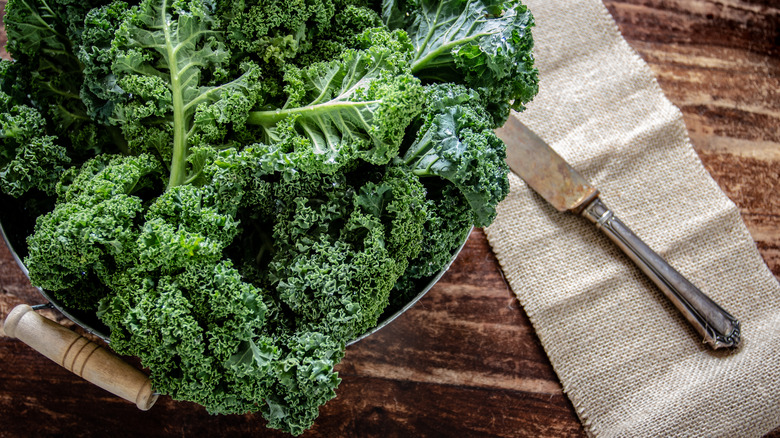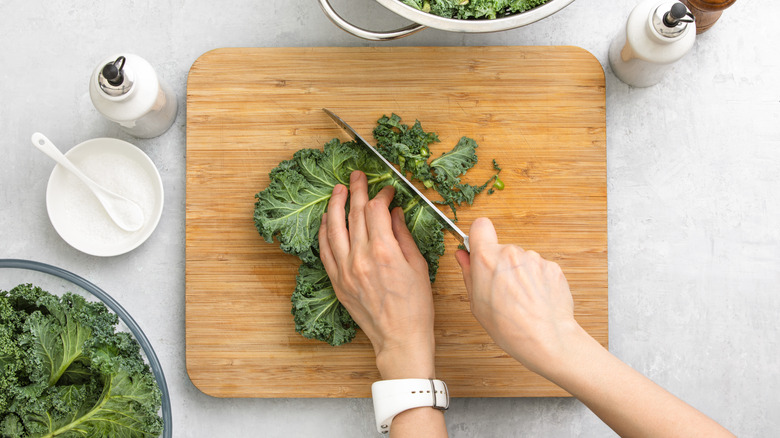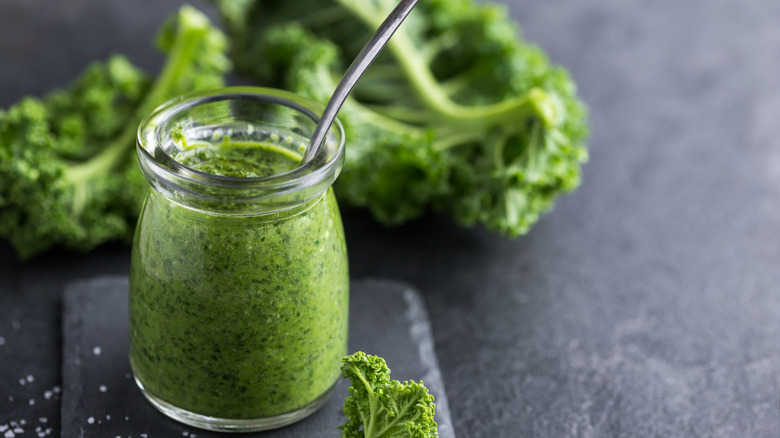The Key To Storing Kale So It Actually Lasts
Kale is a pleasantly bitter green with incredible versatility in both cooked and raw dishes. Even better, the different varieties of kale each come with their own distinct colors and textures, from the bumpy-skinned dinosaur kale to the tight-packed bunches of curly kale. Kale seems so durable and strong (have you ever tried to eat a raw stem?), but like any vegetable or fruit, kale wilts and eventually spoils if not stored correctly. Having to toss out kale because it has gone bad is an obvious issue if you're trying to reduce food waste, so knowing the best way to keep this nutritious green in tip-top condition in storage is a must.
To start with, kale shares a golden rule with many other produce items: Don't wash it until you're going to use it; excess moisture is its enemy. With that in mind, when storing kale in the fridge, you want to make sure you're either wrapping the greens in something absorbent or drying them thoroughly before storage if you did choose to wash them first. And if you need to keep your kale longer-term, the freezer is actually a fantastic option. With these tips, your greens should actually last in storage the way you intend them to when you place them in the crisper drawer with dreams of kale Caesar salads and Buddha bowls.
Storing kale in the fridge
Kale can be stored in the fridge in its whole form or in pieces. For whole bunches, wrap each one in a couple of paper towels or a kitchen towel, and place the bundle in a zip-top bag. Put the bag in the crisper drawer with the kale stems facing the back of the fridge. Every three days or so, swap out the towels to prevent absorbed moisture from hanging out too long. Kale should keep fresh for one week with this method. Another option for longer-lasting whole kale is to bundle it up thoroughly in tinfoil instead of (or in addition to) towels. Though your mileage may vary, the kale can stay crisp and green for at least up to two weeks.
To store kale in pieces, wash and rinse each leaf before either breaking them off the stems or using kitchen scissors or a paring knife for the job. Dry the leaves very thoroughly by using either a salad spinner or rolling them up like a burrito in kitchen or paper towels. Apply gentle pressure until all water is absorbed. You may then wrap the bunches of leaves in kitchen towels and store them in a zip-top bag in the crisper drawer for up to a week. No matter how carefully you've stored your greens, keep an eye out for signs that they've gone off. This includes a faded color, wilted leaves, a mushy texture, or any mold or foul odors.
Storing kale in the freezer
If you have more kale than you can use for at least several weeks, you can store it in the freezer. Done correctly, freezing keeps kale good for up to six months, not to mention holding onto its nutrients, color, crispness, and flavor. There are more steps to this process than with fridge storage — it involves cooking and blanching the kale before storage — but the results are worthwhile.
First remove the leaves from the stems of the kale. Start a large pot of water to boil and fill a medium to large bowl with ice water. Boil the kale leaves for about one to two minutes, or until their color becomes more vibrant. Drain with a colander, dry the leaves very well, and spread them on a rimmed baking sheet, taking care not to pile them up. Place the sheet in the freezer and wait two to three hours or so for the leaves to freeze solid. At this point, you can transfer them to a freezer-safe zip-top bag and keep them frozen for up to six months. There's no need to thaw the kale; you can just toss it frozen into your blender or into a pot of soup and treat it as fresh kale.
You can freeze without blanching, though blanching inactivates the enzymes within the leaves that sap its color, flavor, texture, and nutrient content. If you do choose to forgo blanching, make sure you use the kale within a month.


